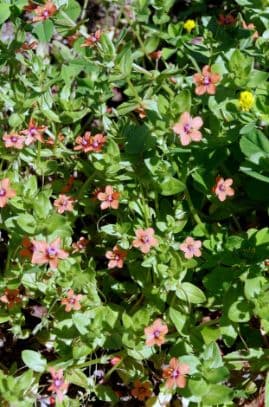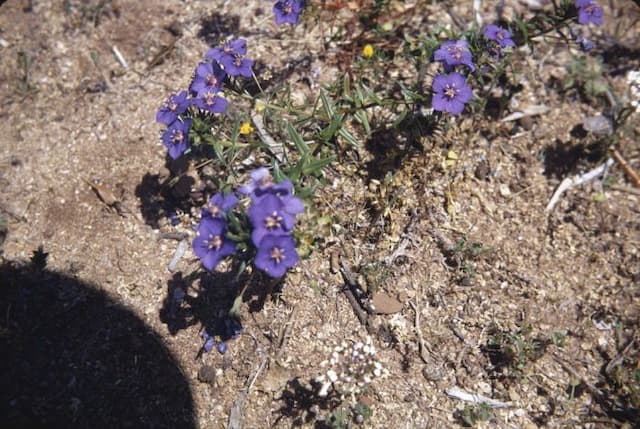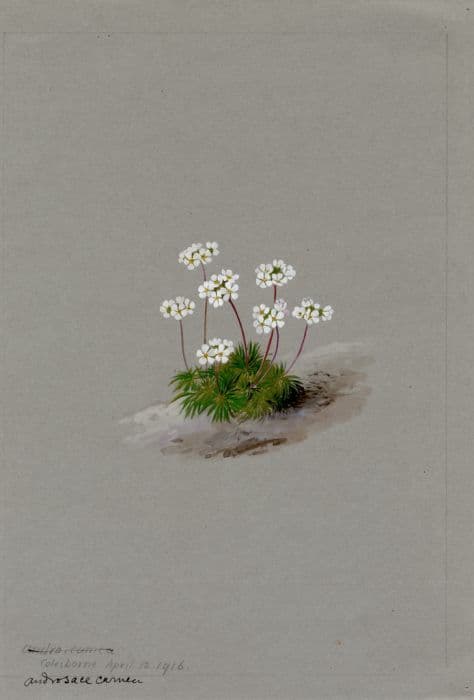Greek Cyclamen Cyclamen graecum

ABOUT
The plant commonly known as the Grecian cyclamen features a noticeable appearance due to its beautiful and unique flowers and foliage. It has heart-shaped, dark green leaves that often exhibit a silver-marbled pattern on the surface, contributing to its decorative look. The flowers of the Grecian cyclamen are particularly striking, with upswept petals that give them a look reminiscent of butterfly wings. These blossoms can be found in a variety of colors, including shades of pink, white, and magenta, adding a burst of color to its surroundings. The flowering typically occurs in autumn, providing a lovely contrast to the changing leaves of the season. The plant as a whole presents a delicate and ornamental appearance that can be appreciated in garden settings and as a potted indoor plant.
About this plant
 Names
NamesSynonyms
Greek Cyclamen, Hardy Cyclamen
Common names
Cyclamen graecum subsp. graecum, Cyclamen libanoticum Hildebr., Cyclamen graecum f. albiflorum Grey-Wilson.
 Toxicity
ToxicityTo humans
The Greek cyclamen contains toxic saponins in its tubers primarily, but all parts of the plant are considered toxic. If ingested, the plant can cause symptoms such as nausea, vomiting, and diarrhea. In severe cases, ingestion can result in heart rhythm abnormalities, seizures, and even death, though such extreme reactions are rare. It is important to avoid consuming any part of the Greek cyclamen.
To pets
The Greek cyclamen is also toxic to pets, such as cats and dogs. Similar to its effects on humans, the saponins found in the tubers and the rest of the plant can cause symptoms, which may include drooling, vomiting, diarrhea, and a loss of appetite. More severe cases can result in heart issues, seizures, and potentially be life-threatening. If a pet ingests any part of the Greek cyclamen, it is advisable to seek immediate veterinary care.
 Characteristics
CharacteristicsLife cycle
Perennials
Foliage type
Evergreen
Color of leaves
Variegated
Flower color
Pink
Height
6 inches (15 cm)
Spread
6 inches (15 cm)
Plant type
Bulb
Hardiness zones
9
Native area
Greece
Benefits
 General Benefits
General Benefits- Ornamental Value: Cyclamen graecum, commonly known as Greek cyclamen, is appreciated for its striking flowers, which add aesthetic value to gardens and indoor spaces.
- Drought Resistance: The plant is adapted to survive in conditions of low water, making it suitable for xeriscaping and regions with water scarcity.
- Shade Tolerance: Greek cyclamen can thrive in shaded areas where other plants might struggle, allowing for varied garden designs.
- Seasonal Interest: It blooms in autumn, providing color and interest in the garden during a season when many other plants are no longer flowering.
- Wildlife Attraction: The flowers of Greek cyclamen can attract pollinators like bees, contributing to the health of the local ecosystem.
- Low Maintenance: It requires minimal care beyond the initial establishment, making it an easy choice for both novice and experienced gardeners.
- Compact Size: Its small and compact growth habit makes it suitable for growing in containers or limited space gardens.
 Medical Properties
Medical Properties- This plant is not used for medical purposes.
 Air-purifying Qualities
Air-purifying QualitiesThis plant is not specifically known for air purifying qualities.
 Other Uses
Other Uses- Cyclamen graecum bulbs can be used as an insect repellent when placed in drawers or closets, helping to protect clothes from moths and other insects.
- The crushed leaves of the cyclamen are sometimes used in traditional practices to create a paste that can deter pests from plants.
- In some cultures, the petals of the cyclamen are used to create natural dyes for fabrics, offering hues of pink and purple depending on the concentration.
- The juice extracted from cyclamen can be applied to arrow tips or tools as a hunting aid by certain indigenous communities, although this is not a common or widespread use.
- The plant's sap, when applied to fishing nets, is believed by some fishermen to increase the durability of the nets and protect them from decay.
- Cyclamen leaves, when dried and infused, can be added to potpourri blends for a light, floral fragrance that freshens up the home.
- Landscapers may use cyclamen plants as a living mulch to suppress weeds due to their dense and low-growing foliage.
- Artists sometimes use cyclamen petals pressed into paper to create botanical prints or to embellish handcrafted greeting cards.
- Dried and powdered cyclamen tubers have been historically used in the tanning industry to assist in leather processing.
- Decorative purposes: Cyclamen flowers and leaves are sometimes incorporated into floral arrangements or used as garnishes on high-end culinary dishes for an aesthetic appeal.
Interesting Facts
 Feng Shui
Feng ShuiThe Cyclamen is not used in Feng Shui practice.
 Zodiac Sign Compitability
Zodiac Sign CompitabilityThe Cyclamen is not used in astrology practice.
 Plant Symbolism
Plant Symbolism- Love and Affection: Cyclamen often symbolizes sincere love and affection due to its heart-shaped leaves and vibrant flowers that bow down as if they are shy or modest.
- Deep Sentiments: The plant is believed to convey deep emotions and is sometimes given as a gesture to express feelings that are not easily put into words.
- Goodbye and Parting: Cyclamen can indicate a farewell or the end of a relationship because the flowers droop as they age, suggesting a sort of parting or conclusion.
- Resilience and Survival: Due to its ability to endure and bloom in cooler climates, cyclamen is also a symbol of resilience and the will to survive through tough conditions.
 Water
WaterThe Greek Cyclamen requires careful watering, and it is ideal to check the soil before adding water. Water the plant when the top inch of the soil feels dry, which may mean watering once a week, using approximately one cup of water each time. It's important to avoid overwatering, as the tubers can rot. During the plant's dormant period in the summer, reduce watering significantly. Always water directly onto the soil, not over the leaves, to prevent rot.
 Light
LightThe Greek Cyclamen prefers bright, indirect light. It's best to place the plant near a window that receives ample light but is shielded from the direct rays of the sun, such as an east-facing or north-facing window. Direct sunlight can scorch the delicate leaves, whereas too little light can cause the plant to become leggy and affect blooming.
 Temperature
TemperatureGreek Cyclamen thrives in cooler temperatures, ideally between 60 to 75 degrees Fahrenheit. They can survive in temperatures as low as 40 degrees Fahrenheit and as high as 80 degrees Fahrenheit, but prolonged exposure to the extremes can be detrimental to the plant's health. The cooler nighttime temperatures help to prolong the bloom period.
 Pruning
PruningPruning Greek Cyclamen involves removing dead or yellowing leaves to encourage healthy growth and aesthetic appeal. The best time to prune is just after the blooms fade, typically in late spring. Trim away only the affected parts, and do not cut back the plant drastically. Pruning is only needed occasionally, mostly to tidy up the plant.
 Cleaning
CleaningAs needed
 Soil
SoilGrecian cyclamen prefers a well-draining soil mix with added organic matter, such as peat or leaf mold. An ideal pH range is slightly acidic to neutral, around 6.5 to 7.0.
 Repotting
RepottingGrecian cyclamen should be repotted every couple of years or when the tuber outgrows its pot; best done when the plant is dormant.
 Humidity & Misting
Humidity & MistingGrecian cyclamen thrives in moderate to high humidity levels, ideally between 50% and 70%.
 Suitable locations
Suitable locationsIndoor
Place in bright, indirect light away from heat sources.
Outdoor
Partial shade, sheltered from heavy rain and strong winds.
Hardiness zone
9-11 USDA
 Life cycle
Life cycleCyclamen graecum, commonly known as Greek cyclamen, begins its life cycle as a seed, which germinates in autumn to produce a small tuber. The tuber sends up leaves and roots, usually during the cooler months of fall, where it will benefit from the moist but well-draining soil. Throughout the winter and into spring, the Greek cyclamen produces its distinctive and ornamental flowers which can range in color from pink to purplish-pink, with a characteristic magenta blotch at the base. After pollination, typically by insects, the flowers give way to seed pods that swell and eventually reach the soil surface, where they release their seeds. The above-ground parts of the plant die back as the summer heat sets in, entering a dormant period where the tuber rests. With the arrival of cooler and moister conditions in the subsequent autumn, the cycle begins anew with the emergence of new leaves and the cyclamen resumes growth.
 Propogation
PropogationPropogation time
Spring-Early Summer
Cyclamen graecum, commonly known as Grecian cyclamen, is often propagated by seed. The best time for sowing cyclamen seeds is in the summer to early fall when temperatures are mild. The seeds require soaking in water for 12 to 24 hours before planting to help break dormancy. After soaking, sow the seeds in a tray filled with a well-draining soil mix, covering them lightly with soil. It is important to keep the soil consistently moist but not waterlogged and to maintain a temperature of around 60 to 65 degrees Fahrenheit (15 to 18 degrees Celsius) during germination, which can take 30 to 60 days. Once the seedlings develop true leaves, they can be carefully transplanted into individual pots. Regular care, including watering, feeding, and proper lighting, should be continued to foster growth.









